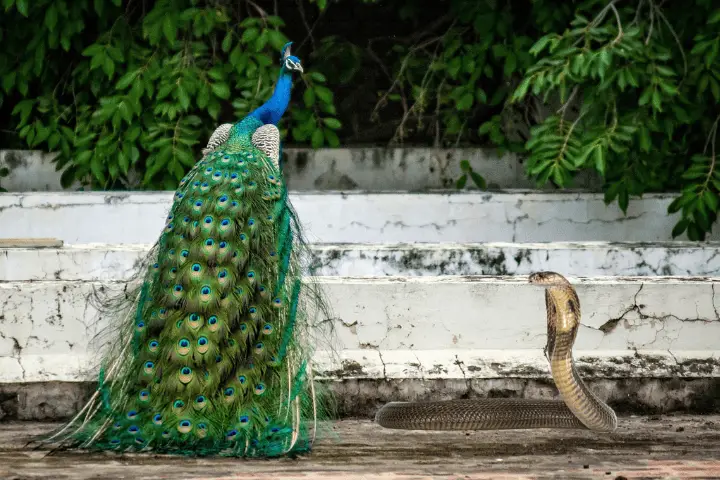Do Peacocks Eat Snakes
These majestic birds, known for their eye-catching feathers, have a varied diet of both plants and small animals.
Peacocks are not fussy eaters and will consume various food items to get their nutrients.
Fruits, seeds, grains, and insects are their primary meals. They find these in trees and on the ground, using their strong beaks to crack open nuts and seeds.
Surprisingly, peacocks are not only vegetarian. They’ve been seen eating lizards and even snakes!
Although they mainly rely on vegetation for sustenance, the fact that they eat snakes shows their adaptability and survival skills.
It should be noted that not all peacocks eat snakes. It only happens when other food is lacking.
Their sharp vision helps them spot prey from a distance and they grab it with their sharp beak.
Background information on peacocks and snakes
Peacocks and snakes have an unexpected connection. You may be surprised to find out that peacocks eat snakes!
These birds are known for their beautiful feathers but they’re also formidable hunters. Peacocks are omnivores, consuming plants and animals alike.
Small creatures such as insects, reptiles, even rodents are all fair game.
What’s more, their natural immunity allows them to consume venomous prey without being harmed. There’s even a story of a peacock saving an Indian village from a deadly snake infestation.
The peacock bravely hunted down each snake until the village was safe once again.
Evidence of peacocks eating snakes in the wild
Peacocks are renowned for their luminous plumage and graceful shows. But they’re also notorious for their eating habits, primarily feasting on fruits, berries, and seeds.
Evidence suggests, however, that peacocks do eat snakes in the wild.
Their sharp beaks and long talons give them the strength to overpower and kill snakes. Researchers have observed this behavior in peacocks in different habitats.
Plus, they possess sharp sight and hearing, helping them spot snakes from afar.
An awesome account tells of a photographer who watched a male peacock fight a venomous snake. The bird fearlessly used its beak to strike precisely and avoid the snake’s fangs.
After an intense struggle, the peacock won.
These fascinating tales suggest that peacocks can and do eat snakes in their natural environment. But these events may be rare due to the availability of other food sources.
Peacocks prove that even the most glamorous creatures can be fond of slithering surprises!
Factors influencing the consumption of snakes by peacocks
Snakes are a food option for peacocks, depending on their availability in the habitat. High abundance of snakes means they are more likely to be eaten.
This could be due to seasonality, weather, and location.
Peacocks are predators with sharp beaks and strong claws. This helps them hunt and eat snakes.
They also have dietary preferences, such as lizards and small mammals. Therefore, they may choose to consume snakes.
We can help peacocks in certain areas by maintaining healthy ecosystems with diverse fauna and flora.
This way they have a variety of prey, without relying on snakes.
Comparative analysis of peacocks’ diet with other bird species
Peacocks have a different diet than other birds. Let’s explore what they eat.
Fascinatingly, peacocks have a partiality for reptiles which sets them apart from the other birds.
Eagles eat small mammals and fish; sparrows eat seeds and small insects; and owls eat rodents and birds.
We can understand the dynamics between bird species better by analyzing their diets. To help these creatures, we can protect their natural habitats and plant trees that bear fruit.
This helps preserve biodiversity and encourages harmony with peacocks and other birds. We can make sure they have the food they need for a sustainable coexistence.
Lastly, we can remember that even the prettiest birds have a darker side.
Importance of peacocks eating snakes for ecological balance
Peacocks play a key role in preserving ecological balance by eating snakes. This keeps the reptile population in check and avoids them becoming too abundant and dangerous to other creatures.
Moreover, their diet consists of various bugs and small animals which helps maintain a diverse food chain in their environment. This creates a sound balance of predator-prey dynamics and supports the health of their habitat.
It’s important to note the major contribution peacocks make in controlling snake populations for a peaceful coexistence with other species.
Moreover, peacocks have outstanding feathers that have multiple purposes other than their good looks. These magnificent feathers work as eye-catching displays during courtship, aiding in successful breeding.
As well, they can act as a visual warning against potential predators, as their bright patterns can intimidate or confuse attackers.
In addition to their part in snake control and their beautiful feathers, peacocks also give valuable nutrients to their surroundings through their droppings.
These feces are rich in nitrogen and act as natural fertilizers for plants in the area. This adds to the growth and vitality of vegetation, which sustains a broad array of plant species and provides nutrition for other plant-eating animals.
Conclusion: The significance of peacocks’ ability to eat snakes in their natural habitat.
The ability of peacocks to consume snakes is incredibly important. They are valuable allies to the delicate ecosystem, controlling snake populations.
These majestic birds have sharp vision, enabling them to spot even the best-hidden serpents. Their long legs and agile bodies help them overpower and subdue venomous snakes.
This skill not only protects them, but other species in their habitat too.
By consuming snakes, peacocks regulate their numbers. This reduces human-snake conflicts and saves agricultural lands from potential threats.
Preserving peacock habitats is essential for ensuring they can continue to control snake populations. Destroying these habitats would have detrimental impacts on peacocks and snake control efforts.

